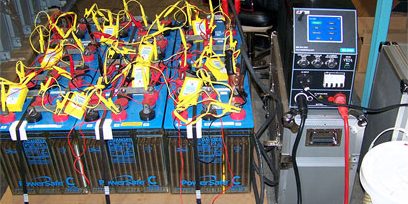As much as backup batteries are helpful, the market is starting to be filled with all kinds of players in this industry. Many offer their batteries for various prices and it can be difficult to differentiate between what’s good and what’s bad.
Thankfully we are here to help you distinguish between what is a quality backup battery and what’s a cheap one. From our own experience, we can narrow the differences down to three specific features that batteries give you. Any cheap backup battery you’ll find will lack these features.
Double Conversion
Referred to as uninterruptible power supplies (or UPS), this feature ensures that there is no delay in switching backup power or filtering out electrical issues. With UPS, the battery is always online and ready to activate any time it’s needed.
The reason for that is they are constantly converting th input AC power to DC power. They then take that DC power from the batteries and convert them back to AC power for the attached electronics that need it. In short, these batteries guarantee that you are getting clean continuous power no matter what happens to the input side of things.
Beyond that, batteries that offer these have other features like electrical noise filtration, voltage regulation, frequency correction, and other power condition features for any and all electronics. With a battery that has double conversion, you’ll have better output power than you could ever get from a wall socket.
Pure Sine Wave Output
To understand this, you need to understand what a pure wive is. When you are plugging electronics into a wall socket, you’ll get pure sine wave power. Any new pieces of technology these days require these pure sine waves to even function at this point. On the other hand, older pieces of technology can function on sub-par wave forms.
What this all means is that if you go for a cheap backup battery with UPS capabilities, that battery may not be able to power the normal operations of certain appliances. This defeats the purpose of backup batteries since they are designed to power appliances in the event of power outages.
Another way to look at this is that the cheap batteries have compatibility issues with the tech that you’re trying to power. And the only way to tell if there is a compatibility issue is by performing an unplug test or going through a power outage.
90% Or Greater Efficiency
The last difference is efficiency. Efficiency is measured by how much power the battery uses. A quality backup battery will have a 0.9 power factor. Another way to call that is 90% efficiency. Some backup batteries are able to gt up to 99% efficiency even.
When looking at cheaper batteries, you’ll find those batteries to be below 90% in all instances. What this means is it’ll use up more power to power our things and it’ll cost you more as a result.
If you can’t find the power factor anywhere on the batter, all you ned to do is find the watt rating of the battery by the (k)VA rating. You’ll get a decimal which you can convert to a percentage.
The big takeaway from all this is that you get what you pay for. But by doing a little bit of research, you’ll find it easier to sift through a lot of the cheap batteries and find a good battery that can benefit you for years to come.








